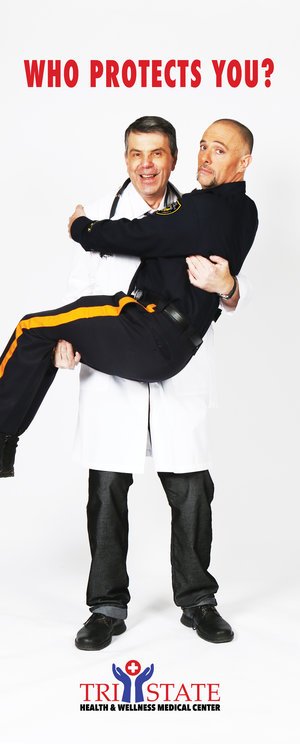Police are not the problem: Police are the solution.
/By: Joel E. Gordon
“The police are the public and the public are the police; the police being only members of the public who are paid to give full time attention to duties which are incumbent on every citizen in the interests of community welfare and existence.” - Robert Peel
This is the message that we MUST get out.
Why are the police paid? Training, knowledge plus the fortitude to deal with enraged, often chemically altered individuals in life and death situations are a primary reason that paid professionals are necessary to carry the burden of keeping the peace, often under impossible circumstances.
As someone who has served as an inner-city police officer, I can unequivocally state that cops do more good for their communities than anyone else yet often don't even have a seat at the table while non-experts work to “reimagine” policing. While the untrained armchair police proffer tactical advice based upon emotion their suggestions actually can further elevate risks. It is obvious who has never been actively confronted by an enraged individual who is in a violent and often chemically altered state of mind impervious to pain.
I am particularly reminded of the time that I was confronted by an enraged individual I was tasked to attempt to keep from harming himself or others, later revealed to be under the influence of PCP. Phencyclidine works primarily as an NMDA-receptor antagonist. Behaviorally in humans, its effects are broad-spectrum and can induce hostility, delusions and hallucinations - psychotic effects somewhat related to the positive symptoms seen in schizophrenia. While no evidence exists that PCP can increase strength per se, it does act as a dissociative analgesic, producing a sense of non-connectedness neurologically and a general decrease in pain sensation peripherally. The combination of properties -- with delusions, hallucinations and aggression -- can produce a physiological state where it appears the person is capable of superhuman feats, whereas the reality is only that they are more capable of/willing to commit self-harm and harm others. This particular individual was so powerfully violent in a hospital emergency department that it took six officers to control his violent physical movements until he could be medically “knocked out” to gain control. Imagine the lone officer encountering this individual or someone like him in an uncontrolled setting.
You’ve heard some of the “recommendations” of those who have never experienced such an encounter in a variety of other situations:
Warning Shots: Warning shots are prohibited in just about every jurisdiction in the U.S. Any discharge of a firearm by the police is typically classified as a use of deadly force incident. The officer is responsible for where the bullet goes and any damage it may cause. It should not be too difficult to understand that a warning shot could easily result in an errant bullet lodging somewhere that it does not belong and at the very least, if shot in an upward trajectory, what goes up must come down.
Shoot them in the leg: If struck in a lower extremity this may not stop a threat in a timely manner but it is still a potential actual deadly force by severing a femoral artery or other area causing a person to ultimately "bleed out." If the bullet completely transected the artery, the person would likely lose enough blood to be severely compromised within a minute or two, and they'd bleed out in under five minutes without prompt treatment and transport to a hospital.
Shoot any weapon out of their hand: Maybe on television or in a movie, but in real-time real world scenarios even the best marksman could not be assured of a clean shot in a frantic uncontrolled environment except perhaps in the rarest of circumstances.
Use of Chemical Irritant, Taser or Less Lethal Weapon: Level four or five on the use of force continuum (below). Designed to temporarily incapacitate, confuse, delay or restrain an adversary in a variety of situations but are not necessarily reliable to stop an active threat in all instances such as with an individual who is “feeling no pain,” for example.
Rather than a theoretical hypothesis of what could stop a threat law enforcement professionals use a force continuum, a scale of force alternatives, to mediate the level of response used in a given situation. This continuum has been professionally developed in collaboration with those who possess real knowledge and expertise in a variety of disciplines including behavioral science, defense tactics, anatomy and physiology, ballistics, the law and real-world experience.
The force continuum is typically broken down into six broad levels. Each level is designed to be fluid as the need for force changes as the situation develops. For example, it is not uncommon for the level of force to go from level two, to level three, and back again in a matter of seconds.
· Level 1 - Officer Presence: The mere presence of a police officer in uniform or in a marked vehicle is often enough to stop a crime in progress or prevent most situations from escalating. Without saying a word, the mere presence of a police officer can deter crime by the simple use of body language and gestures. At this level, gestures should be non-threatening and professional. This "zero" level of force is the best way to resolve any situation, if possible.
· Level 2 - Verbal Commands: Used in combination with a visible presence, the use of the voice can most often achieve the desired results. The content of the message is as important as your demeanor. It’s always best to start out calm but firm and non-threatening. Your choice of words and intensity can be increased as necessary or used in short commands in more serious situations. Police officers receive extensive training on how to use verbal commands most effectively.
· Level 3 - Empty Hand Control: Some situations will arise where words alone will not reduce the aggression. This is the time police officers will need to get involved physically. This is a level of control employed by police officers minus the aid of equipment or weapons. There are two subcategories called, “soft empty hand techniques” and “hard empty hand techniques.”
· Level 4 - Pepper Spray, Baton, Taser: When the suspect is violent or threatening, more extreme, but non-deadly measures must be used to bring the suspect under control or affect an arrest. Before moving to this level of force, it is assumed that less-physical measures have already been tried. Pepper spray, once thought an effective street tool for police officers has lost popularity over the years because of its ineffectiveness, especially on intoxicated persons. A blow with a baton can immobilize a combative person, allowing officers to affect an arrest. The Taser discharges a high-voltage spark (50,000 volts) at very low amperage. The Taser fires two small darts, connected to wires, which drops a suspect at non-contact distance. They can be especially useful for controlling non-criminal violent behavior, such as persons who are mentally impaired.
· Level 5 - Less Lethal: This is a newer, acceptable and effective level of force that numerous police agencies have added to their use of force continuum policy and procedure. Less-lethal weapons were developed to provide law enforcement, military and corrections personnel with an alternative to lethal force. They were designed to temporarily incapacitate, confuse, delay, or restrain an adversary in a variety of situations. Less-lethal weapons can be valuable when: lethal force is available as backup but it is determined that lesser force may subdue the aggressor or when lethal force is justified but its use could cause serious collateral effects, such as injury to bystanders.
· Level 6 - Deadly Force: If a police officer has probable cause to believe that a suspect poses a significant threat of imminent death or serious physical injury to the officer or others, then the use of deadly force is justified. It is obvious from all of the news about misuse of power by police, that this is easier said than done.
By the very nature of law enforcement, officers can be confronted with a potentially lethal threat at any given time. In many of these instances, officers may have no other reasonable option, given the totality of the circumstances, but to discharge their firearm in order to protect their life or the lives of others.
The use of force is an integral part of a law enforcement officer's job, particularly when arresting criminal suspects. While most reasonable people believe that police should be permitted to protect themselves and others from threats to safety, what is often disputed is an officer's assessment of a threat and the level of force selected to counter it. The level of force used must be tailored to the nature of the threat that prompted its use. In other words, a response is fully dictated by the actions and threat level of a perpetrator.
Although central body mass is the most reliable and accessible target proven to be likely to stop a threat, even a center body mass shot or shots does not necessarily guarantee an immediate stop to aggression. Case in point: In February of this year a Montgomery County, Maryland, sheriff’s deputy was seen on a widely viewed internet video firing 12 rounds, striking an attacking individual at close range, after the deputy backed away, tried de-escalation, and attempted Taser deployment before the subject finally stopped his forward aggression and the attack ceased. A nearly identical situation, in the days before Tasers, was famously taught in the Baltimore City Police Academy of the ‘80s where a hostile aggressor failed to cease attack quickly after being shot numerous times center mass. Police are taught never to take anything for granted and always remain flexible in their response because in real-world scenarios there is no guarantee that any one technique will immediately stop an enraged aggressor. These life and death situations are not taken lightly.
Is it ever OK to use deadly force?
While there is always room for improvement, more tools and deployment training, it is not realistic to completely eliminate the use of deadly force by the police ... nor should it be in cases involving imminent danger in the maiming or death to innocent members of the public or to the police. There is no license for the police to kill, only a responsibility to stop a threat, to protect oneself and the people who need protection from those who are causing catastrophic harm to those around them. Who has their finger on the pulse of a community more than a front line community cop on the beat who has a sense of obligation toward the community in doing what is best for the overall safety and common good of the areas served? The answer lies within each dedicated and good-hearted law enforcement professional. May the protectors of our society always be the ones to prevail.
Joel E. Gordon is a former Field Training Officer with the Baltimore City Police Department and is a past Chief of Police for the city of Kingwood, West Virginia. He has also served as vice-chair of a multi-jurisdictional regional narcotics task force. An award winning journalist, he is author of the book Still Seeking Justice: One Officer's Story and founded the Facebook group Police Authors Seeking Justice. Look him up at stillseekingjustice.com










